| |
Ingredient Innovations for Dairy Products
|
 |
|
|
|
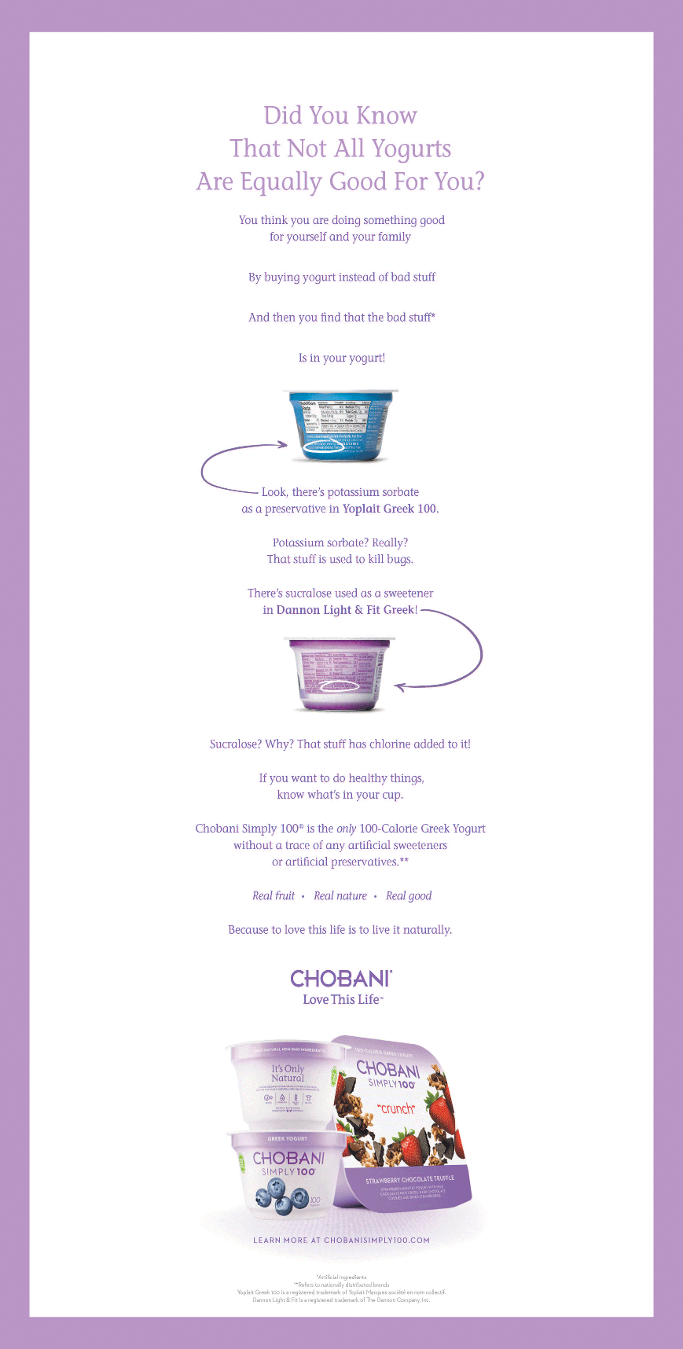 |
|
|
|

|
- SCORE A HOMERUN THIS COMING ICE CREAM SEASON (posted December 19, 2013)
- The Little Slugger introduces baseball-inspired ice cream cones for retail, foodservice and commercial manufacturing.
- These patented baseball bat shaped ice cream cones will hit retail shelves in spring 2014 with the start of Major League Baseball.
- “The Little Slugger offers a new twist on an American tradition for kids,” says Tony Antonacci, CEO “Baseball is America’s favorite pastime and accounts for much of youth play activity in the U.S. There is no better feel-good tradition than for a team to enjoy ice cream after a game--win or lose--to build camaraderie.”
- The line includes cake and sugar cones, with the retail packages including red sprinkles for interactive play.
- For more information, visit www.thelittleslugger.com
|
|
|
|
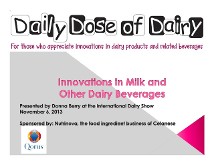
View this presentation by clicking on the photo album to the right.
|
|
|
|
|
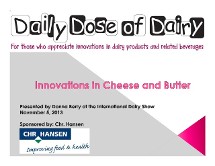
View this presentation by clicking on the photo album to the right.
|
|
|
|
|
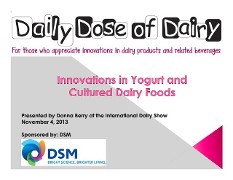
View this presentation by clicking on the photo album to the right.
|
|
|
|
|

View this presentation by clicking on the photo album to the right.
|
|
|
|
|

|
- INGREDIENT TECHNOLOGY TRENDS FROM THE 2013 INSTITUTE OF FOOD TECHNOLOGITS (IFT) ANNUAL MEETING + FOOD EXPO (posted July 18, 2013)
- Read more HERE.
|
|
|
|

|
- INGREDIENTS THAT ALLOW FOR A GRADUAL REDUCTION IN SODIUM (posted November 30, 2012)
- Despite increased awareness about the risks of too much sodium in consumers’ diets and pledges from governments around the world to reduce salt levels in food, product launches with low/no/reduced sodium claims have been nominal, according to market research firm Mintel.
- (Read HERE about how dairy processors are making progress in sodium reduction in a recent article I wrote for Food Business News.)
- “A large percentage of the global food industry remains wary of the commercial impacts of reducing salt in their products. This anxiety is well-founded, with many products positioned as low sodium forced off the shelves prematurely in recent years due to poor sales,” according to Chris Brockman, global food and drink analyst at Mintel. “Consumers are concerned about salt intake, but are not willing to compromise on taste.”
- According to Mintel’s research, some 54% of U.S. consumers say they limit their use of packaged snacks and other packaged foods because they think they have too much salt or sodium, and 53% are concerned about the amount of salt or sodium in their diets. However, it seems consumers will not give up salt easily. When it comes to products flavored with a non-sodium or salt alternative, almost half (46%) of consumers in the U.S. think that they don’t taste as good as their traditional counterparts.
- “Brands will need to dispel widely held perception about low sodium or salt alternatives to be successful. Fortunately, this is possible,” says Brockman. “Many food brands are already introducing step-by-step salt reduction programs that gradually reduce the salt content of their products, a strategy often called ‘stealth health,’ as the incremental removal of sodium can be carried out over a period of time to help the consumer to become accustomed to the changed flavor profile, without the need to flag that up prominently on-pack and thus deter consumers who may perceive ‘less taste.’ Other brands are also steering clear of the health issue by experimenting with different flavor profiles, such as strong spices and vinegars, to enhance taste while eliminating sodium.”
- Dairy processors, specifically cheese manufacturers, have a number of tools available to take the stealth health approach.
- Read HERE about how dairy processors are making progress in sodium reduction in a recent article I wrote for Food Business News.
|
|
|
|

|
- SEASONING SHEETS FOR CHEESE AND BUTTER (posted October 30, 2012)
- At the Innovation Stage at Pack Expo, suppliers show off their latest and greatest. On Sunday, one packaging supplier had Corporate Chef Rick Tarantino, a frequent on television cooking programs, provide insight to an innovative ingredient application process that works on cheese and butter, (as well as all types of proteins).
- Flavorseal’s patented seasoning transfer technology involves seasonings that are pre-applied to packaging using a food-grade adhesive.
- The technology comes in a number of forms. For cheese and butter, the sheets make the most sense.
- The technology allows cheese and butter manufacturers, or even deli operators, the flexibility to respond to changing flavor interests in the marketplace without changing the base the material, in this case, it would be the block of cheese or butter.
- It allows them to expand existing product lines by simply applying a flavorful seasoning transfer sheet to the cheese or butter. The moisture in the cheese or butter transfers the flavor and seasonings from the sheets to the product. When the sheet is lifted, the seasoning surface is left on the product.
- It’s an easy, one-step process that results in a perfect amount of seasoning every time, giving consistent flavor to each bite.
- It eliminates the mess and waste of applying topical seasonings, as well as extra wash downs and changeover times.
- Depending on the application and the desired end result, other ingredients can be included in the seasoning, such as antimicrobials, ground nuts and even dehydrated granules of fruits and vegetables.
- For more information, visit www.flavorseal.com
|
|
|
|
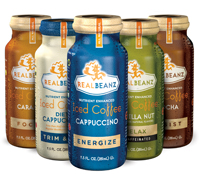
|
- MOOD FOOD (posted September 14, 2012)
- There’s a trend among formulators to incorporate flavorful ingredients that have established effects on health and wellness, a.k.a. botanicals. Read more at the Sept. 14 BLOG.
|
|
|
|

|
- SALT IS DELICIOUS (posted August 17, 2012)
- Sodium, when paired with chloride, makes table salt, an ingredient that not only enhances flavor but also performs various functions in different applications. Table salt also happens to be the chemical reference used to demonstrate the taste of salty, one of the five basic tastes, which includes bitter, sour, sweet and umami.
- Salt is also delicious.
- Take for example the new low-fat Salted Caramel frozen yogurt that launched this week by 16 Handles, one of New York’s premier self-serve frozen yogurt chains. The hint of salt is that layer of deliciousness that turns the sweet taste of caramel into a culinary delight. This better-for-you indulgent snack and dessert combines sweet with salty to offer those who crave these two basic tastes an all-in-one experience.
- To read more about salt as an ingredient, read my August 17, 2012 BLOG.
|
|
|
 |
- WHAT MORE CAN YOU DO WITH CHOCOLATE (posted August 10, 2012)
- Many readers ask for predictions or suggestions as to what they should be creating in their R&D labs.
- It’s time for dairy processors to do more with chocolate.
- For some innovative ideas, read the August 10, 2012 BLOG.
|
|
|
|

|
- NATURAL SUGAR-FREE FLAVORING CAN HELP MOVE MORE MILK (posted July 25, 2012)
- Wisdom Natural Brands recently added three refreshing new summer flavors to its zero-calorie, zero-carbohydrate, zero-glycemic index SweetLeaf Liquid Stevia product line.
- Coconut, Watermelon and Cola join Lemon Drop, Valencia Orange, Berry, Chocolate Raspberry, English Toffee, Vanilla Crème, Hazelnut, Peppermint, Root Beer, Grape, Apricot Nectar, Chocolate, Cinnamon, and SteviaClear.
- With just a few drops, many of these flavors are able to turn a glass of white milk into a flavorful delight without the addition of any calories.
- All 17 flavors come in easy-to-use dropper bottles, so consumers can add as much or as little as their taste buds require.
- With an average of 288 servings per 2-fluid-ounce bottle, SweetLeaf Liquid Stevia also offers great value in addition to a delicious sweet taste.
- For more information, visit www.buywisdom.com.
|
|
|
|

